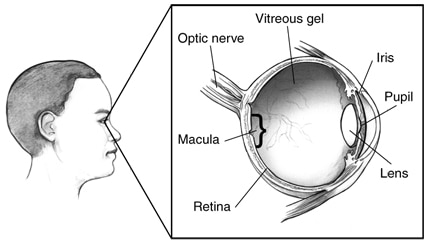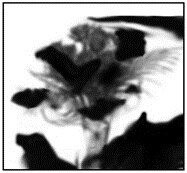How can diabetes affect the eyes?
Source: National Institute of Diabetes & Digestive & Kidney Diseases
Too much glucose, also called sugar, in your blood from diabetes can damage four parts of your eye:
- Retina. The retina is the tissue that lines the back of your eye. The retina converts light coming into your eye into visual messages through the optic nerve to your brain. The macula is the small, sensitive, center part of the retina that gives sharp, detailed vision.
- Lens. The lens of your eye is clear and is located behind the iris, the colored part of your eye. The lens helps to focus light, or an image, on the retina.

- Vitreous gel. The vitreous gel is a clear, colorless mass that fills the rear of your eye, between the retina and lens.
- Optic nerve. The optic nerve, at the back of your eye, is your eye’s largest sensory nerve. The optic nerve connects your eye to your brain, carries visual messages from the retina to your brain, and sends messages between your brain and your eye muscles.
Diabetes damage to your eyes—called diabetic eye disease—can cause permanent vision loss, including low vision and blindness. Low vision means that even with regular glasses, contact lenses, medicine, or surgery, you can’t see well enough to easily complete everyday tasks.
How does diabetes affect the retina?
Over time, having high blood glucose levels from diabetes can damage the tiny blood vessels on the retina. Diabetic retinopathy is the medical term for damage to the retina from diabetes.
Retina damage happens slowly. First, the retina’s blood vessels swell. As retina damage worsens, the blood vessels become blocked and cut off the retina’s oxygen supply. In response, new, weak blood vessels grow on the retina and the surface of the vitreous gel. These blood vessels break easily and leak blood into the vitreous gel. The leaking blood keeps light from reaching the retina.
When that happens, you may see floating spots or almost total darkness. One of your eyes may be damaged more than the other, or both eyes may have the same amount of damage. Sometimes the blood clears out by itself. However, you might need surgery to remove the blood.
You might not have any problems with your vision until the damage is severe, so you should have an eye exam at least once a year, even if your vision seems fine. Call your eye doctor right away if you notice any changes in your vision.
Over the years, the swollen and weak blood vessels can form scar tissue and pull the retina away from the back of your eye. If the retina pulls away, a condition called detached retina, you may see floating spots or flashing lights. You may feel as if a curtain has been pulled over part of what you are looking at. A detached retina can cause vision loss or blindness if you don’t take care of it quickly. See an ophthalmologist—a doctor who diagnoses and treats all eye diseases—right away if you have these symptoms.

Normal vision

Vision with damage to the retina from diabetes
Praise for Healing the Brain
"A book that can help medical professionals as well as the general public, Mr. Balog has tackled a subject that is complex and he makes it quite approachable. It has added and enriched my own practice of medicine by making me more aware of issues not often discussed in medical circles."--Peter Paganussi, MD, Virginia
"Author David Balog has done an excellent job of creating a book for educators (or anyone working with youth) that explains the complicated workings of the brain in an easy to understand manner. Balog goes on to discuss various types of trauma and how the adolescent brain responds to trauma such as depression, stress, addiction, risk taking, PTSD, etc. LGBT/Q youth may experience trauma in ways majority youth often do not. The author shares important coping strategies....I highly recommend this book!"--Carol Dopp, M.Ed.
"David Balog understands the strain of alienation, so he tackles this subject with compassion and concern. Mr. Balog draws on his knowledge of brain science to give readers insight into what happens to young people under tremendous stress, and he offers practical advice on how to help and cope."--Gary Cottle, author
"Provides comfort and learning to the reader. Flows easily from one topic to the next and knits tidbits of information together in a unifying mosaic. Easy to read. Difficult to put down." --Michael J. Colucciello, Jr., New York State Dept. of Mental Health researcher, retired.
"Well researched, fleshed out with relevant case histories, this book packs a lot of solid information into its 152 pages. Written in an engaging style for the layman, it covers a wide range of topics. One learns a great deal about the biology of stress, particularly the vulnerability of the brain in the pre-adult years. This book also provides a glossary of key brain science terms and a listing of organizations serving the LGBT /Q community and resources on the brain."--Gary Bordzuk, librarian

No comments:
Post a Comment